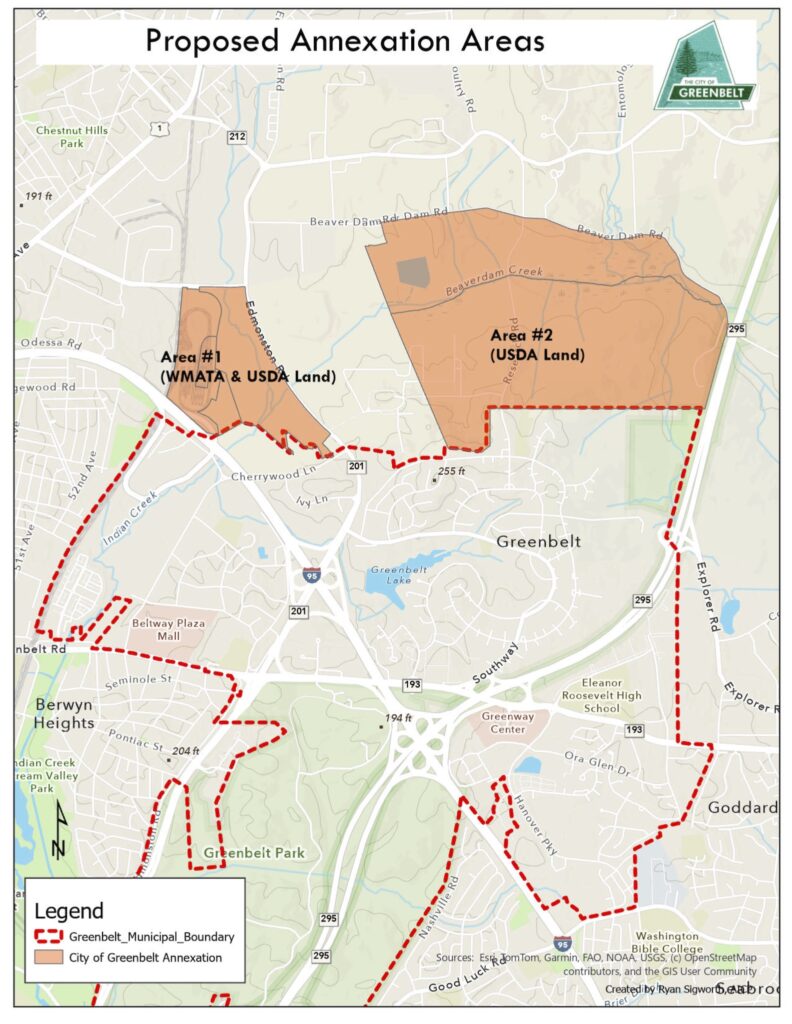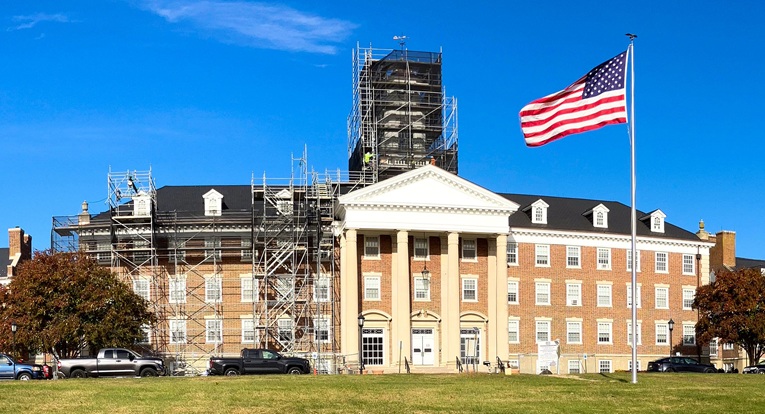On September 24, Greenbelt City Council took its first concrete step toward a potential annexation of portions of large, neighboring federal properties, approving funds and survey work that supporters say will help the city protect green space and gain leverage if the land’s status ever changes. The ordinance for a $70,000 supplemental appropriation to the general fund to cover survey costs and legal fees was introduced for both first and, via a suspension of the rules, second reading at the meeting, and passed 6 to 1.
Survey Work and
Target Areas
The supplemental appropriation authorized hiring Charles P. Johnson & Associates to map legal boundaries, known as metes and bounds, for two target areas contiguous to the city’s boundaries, tied largely to the U.S. Department of Agriculture’s Beltsville Agricultural Research Center (BARC). Those areas, referred to as Area 1 and Area 2, cover land near the WMATA rail yard and within portions of BARC, and are part of roughly 2,215 acres under discussion across three potential annexation zones. A third area, focused more heavily on Goddard Space Flight Center property, was set aside for now.
The survey work for the two areas of BARC will generate the legal descriptions and
boundary maps that the city needs before it can draft an annexation resolution. These documents will formally define which parcels could fall under city jurisdiction and outline the groundwork for later steps, such as public notices and hearings. Council approved contracts for the first two areas at a combined cost of about $36,000.
Purpose, Impact
“It’s about protecting the Green Belt. It’s about protecting the green space, and it’s what we can do,” Mayor Emmett Jordan said, referring to a long-held community desire to protect the green space north of the city. He added that although the city does not have zoning or land-use authority over federal property, annexation would give Greenbelt “a seat at the table” and a chance to weigh in if the land’s ownership ever changed.
Jordan and city staff emphasized that annexation would not transfer ownership. “Annexation simply brings the property into the municipal corporate limits of the city,” City Manager Josué Salmerón said. He explained that while the land would remain federally owned, a change in ownership would make it subject to city codes and local regulations.
Supporters on council say the move could strengthen Greenbelt’s voice in future land-use discussions involving nearby federal properties. They note that the BARC and Goddard campuses are among the largest undeveloped tracts next to the city, and argue that any change in their status could significantly shape how the surrounding area develops.
Development vs. Preservation
Councilmember Rodney Roberts cast the lone no vote and delivered a lengthy critique, arguing annexing portions of the city and neighboring jurisdictions aims to facilitate development instead of preservation. Roberts also objected to spending money on consultants. “We are a city that is facing multimillion-dollar budget deficits … we need to get our fiscal house in order,” he said.
“This is not about land preservation,” Roberts said. “This is going to make it easier for developers to develop BARC. College Park and others want to annex large portions of BARC for tax revenue. I want it preserved, and that’s why I’m voting against this.” On September 9, the City of College Park held a worksession on annexation options for that city, and on September 11, it published a series of annexation options for the city, including one potential annexation option closely aligned to the area Greenbelt is considering.
Several councilmembers pushed back on the suggestion from resident Michael Hartman that the city’s influence would be negligible even after annexation. They cited recent examples inside city limits where, despite county control of zoning, Greenbelt shaped major projects, including commitments for indoor recreation space at Beltway Plaza and design elements at Greenbelt Station.
Responding to resident and current city council candidate Bill Orleans’ objections to pushing through a second reading without public comment, Jordan said, “Greenbelt has learned the hard way in discussing potential annexation.” Neighboring municipalities also have aspirations for annexation. There will be “plenty of opportunities for the public to weigh in,” in the process, said Jordan.
Next Steps
Staff outlined a multistep process that must occur before any annexation can move forward. The first step is completing detailed land surveys and legal descriptions for Areas 1 and 2 ‒ work that Salmerón said will take three to four months. Those documents are required before the city can draft an annexation resolution and begin the formal approval process.
Once a draft resolution is prepared, the city would need to issue formal public notices and release a municipal services and fiscal impact plan as required by state law. At least one public hearing would follow, and residents would retain the right to petition against the proposal.
City officials stressed that these next steps are procedural and do not commit Greenbelt to annexation. Instead, they represent the legal framework the city must complete before the council could vote on whether to incorporate any of the federal land into its boundaries.
Supporting councilmembers framed Monday’s votes as positioning rather than a done deal. “It puts us in a position where we can take action,” Jordan said. “But it’s not actually doing the annexation. It’s preparing everything, so we’re in position to do something quickly, if it’s the council and the public’s will.”
Stephen Lotz is a University of Maryland student at the Philip Merrill College of Journalism writing for the Greenbelt News Review.




